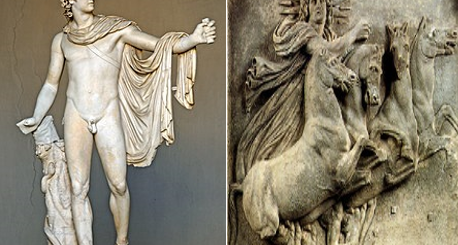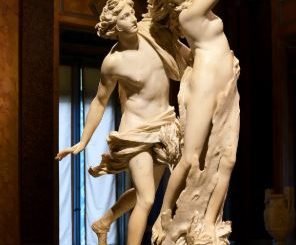I am Hades: King of the Underworld, Lord and Collector of Souls

Ancient Greek God Hades, God of the Underworld and the dead
Ruler of the dead. The Unseen One. The Wealthy One. King of the Underworld. The Collector of Souls. Pluoton.
Take a closer look at Hades, the ancient Greek god of the Underworld.
Hades Origin Story and Meaning
In Greek mythology, Hades was one of the six gods born to the Titans Cronus and Rhea. His five siblings were Olympian gods: Hestia, Hera, Demeter, Poseidon, and Zeus.
Now, when Hades was born, his father Cronus swallowed him up, just like he did to his other siblings, i.e. Hestia, Demeter, Hera and Poseidon. Hence, Hades spent his formative years in the belly of his father.
Read More:
- Most Powerful Ancient Greek Gods and Goddesses
- Greek Titan Atlas – Origin Story, Powers & Symbols
- Myths and Facts about the ancient Greek Goddess Nike
How Hades became Lord of the Underworld
After the birth of Zeus, the last child of Cronus, Rhea decided to put an end to Cronus’ madness and reign of terror. Rhea tricked Cronus. In place of the baby Zeus, she tricked Cronus into gulping up a rock that was presented to look like a baby.
No sooner had Cronus ingested the package than did he begin to vomit up Hades and his siblings. The Olympians, under the leadership of Zeus, went on to fight ferociously against Cronus and the Titans for eons of years. In the end, the Olympians defeated the titans and cast them to the pitch black depths of Tarturus, where the likes of Cronus and his fellow deranged titans were to spend eternity locked up.
Afterward, Hades and his two younger brothers – Poseidon and Zeus – shared the spoils of the war, i.e. the world/cosmos. According to some accounts, the brothers did this by drawing lots. Hades ended up with the realm of the Underworld. Poseidon received the oceans and all the realms in the sea. Zeus ended up with the sky, thus becoming the king of Mt. Olympus.

The mad Titan Cronos disgorging Hades and his four other siblings – Hestia, Hera, Demeter and Poseidon
What does the Realm of Hades (the Underworld) look like?
The ancient Greeks believed that Hades’ realm – the Underworld – was a sunless, gloomy place found beneath the earth. As king of the Underworld, Hades was in charge of all the riches and precious minerals that laid in the earth. The ancient Greeks also believed that the combined wealth of both Mt. Olympus and Poseidon’s vast oceans pales in comparison to the wealth in Hades.
Also known as Hades, the Underworld was place where the souls of the dead went. The god Hades was therefore sometimes seen as the “God of death” or the “Collector of Souls”.
The souls of the dead were first ushered into the Hades by Hermes, the messenger of the gods. From there, Charon – the ferryman – ferried them across the River Acheron (“the River of Woe”).
Read more:
In some versions of the myth, Hades is said to be particularly pleased every time a dead soul arrived in his realm. As a result, he took quite a strong disliking to Asclepius (the Greek god of medicine and healing) , the son of Greek god Apollo. Asclepius was the god of medicine who had the vast knowledge in healing the sick. The actions of Asclepius angered Hades because it reduced the number of people who died.
Depictions & Symbols of Hades

A fresco showing Hades kidnapping Persephone
Hades was portrayed as a dark and glum character with a pitch-black beard. He was stoic with a face that could frighten the bravest of Greek mortals.
The typical depiction of Hades sees him sitting on a throne made of ebony while either his wife Persephone or his three-headed hound dog, Cerberus, stands by his side. In his hand is a beautifully crafted scepter (a two-pronged staff – a bident). Like his throne, his crown is mainly made of ebony and other precious minerals.
It is also believed that he possess a crown that grants the wearer an invisibility power. Perhaps this is what he used to stay under the radar while abducting Persephone. Like many Greek gods, Hades too rode a chariot.
He lived in a gorgeous palace, which no other palace on Mt. Olympus or under the sea could match. Only those with Hades’ invitation could approach this palace.
Was Hades worshiped?
Hades was arguably one of the most feared gods in ancient Greece. Such was this fear and anxiety that ancient Greeks avoided mentioning him by his name. They adopted many epithets to describe Hades. Some of them included: “the Collector of Souls”, “the God surrounded by screams”, “the Guardian of Hell”, “the Unseen/Invisible One”, “The Wealthy One”, “One who lives for pain”, “the King that lay underground”, and among others.
Hades did not have as many temples as his fellow Olympian gods. His temple, the Nekromanteion, was believed to be situated along the River Styx. The temple’s location was on mainland Greece. There were a few worshipers of Hades who honored him by siting temples around volcanic spots. Examples of those places were at Elis and Pylos.
Hades and Persephone
Among all the Greek Olympian gods, Hades was considered one of the most morbid and dark characteristics. His association with death and the Underworld made him an unsavory person.
According to ancient Greek poet Hesiod, Hades resorted to stealing a bride for himself probably because no mortal or goddess wanted anything to do with him. In Hesiod’s account, Hades abducted Persephone, who went on to become his queen in the Underworld. Persephone was the favorite daughter of Demeter, the goddess of agriculture and the grains. This made Persephone Hades’ niece. Bear in mind, marriage within the family was not uncommon in many ancient pantheons.
The story of Persephone’s adoption states that Hades upon sighting the young goddess fell head over heels with her. He immediately trapped her with some magic and drove off with her on his chariot to the Underworld. He made sure that no one saw him commit this act. At least that’s what he thought. That’s because Helios, the god of the sun in Greek mythology, saw everything. Nothing that happened beneath the sun escaped the watchful eyes of Helios.
In any case, Demeter sunk into a serious depression after searching fruitless for Persephone. The myth has it that Demeter roamed the world and mourned the disappearance of her daughter. As a result, she began neglecting her duty of helping crops grow. Soon, massive famine and drought swept across the land as Demeter could not perform her duty of attending to the crops.
Seeing how miserable Demeter and the world was, Zeus decided to intervene. The king of the gods appealed to Hades to release Persephone so that she could be reunited with Demeter. However, before Persephone departed the Underworld, she ate the sumptuous looking pomegranate seeds that were given to her by Hades. In Greek mythology, whenever someone eats in the Underworld, the person gets bound to the place forever. Zeus again intervened and struck a deal with Hades. It was agreed that Persephone would spend one-half of the year on the surface world with her mother. In the remaining half of the year, she will spend it with Hades in the Underworld.
Read more: How the seasons came to being in Greek mythology
Family Tree of Hades

Hades’ family tree | Hades, like his Olympian siblings, is the grandson of primordial goddess of the earth Gaia and the sky god Uranus.
Interesting Hades Facts

Hades myths and facts
- Aside from being scary as hell itself, Hades was considered cunning, deceptive and impulsive sometimes. Come to think of it, which Greek god could claim not to possess one of those characteristics?
- Hades’ epithet “the Wealthy One” is in reference of his dominion over all the riches that are buried in the ground. Not that money and riches meant anything to ancient Greek gods, but if it did, Hades would certainly have been the undisputed richest god in the Greek pantheon.
- Hades spent most of his time in his realm. He only came to the surface world for crucial dealings or events. And although he is considered one of the twelve Olympian gods, he rarely stayed on Mt. Olympus. Then again, it is not as if the deities on Mt. Olympus missed him.
- Hades’ realm is surrounded by five rivers: Cocytus (River of Lamentation), Acheron (River of Lacking in Joy/River of Woe), Styx (River of Vows), and Lethe (River of Forgetfulness).
- The realm of Hades has three main zones: Tarturus, the Elysian Fields, and the “joyless realm of ghosts” (purgatory). The final destination of a dead soul was decided by a panel of three judges called Minos, Aeacus, and Rhadamanthys.
- Hades’ children included Makaria (goddess of a good death), the Erinyes, and Zagreus.
- Contrary to popular opinion, Hades was NOT the god of death in Greek mythology. That title belonged to the god Thanatos. Hades was the god of the dead. Hades only collected and lorded over the dead souls. He had nothing to do with ending the lives of people.
- Due to his association with the Underworld and death, ancient Greeks refused calling Hades by his name. They mostly used epithets to describe him.
- Cerberus, Hades’ three-headed dog, was a fierce creature. He often accompanied his master in the underworld. It was also believed that Cerberus stood guard at the entrance of the Underworld, preventing anyone from leaving the place without Hades’ permission. The hellhound also ripped to shreds anyone attempting to enter Hades without his master’s approval.
- Greek god Hades also possessed a wide array of fearsome creatures (mostly black in color) such as horses, serpents, and beasts. Those animals often acted as his agents.
- In one of the Labors of Heracles (Hercules in Roman mythology), King Eurystheus tasked Hercules to fetch the Hades’ dog Cerberus from the Underworld. Uncharacteristic of him, Hades did indeed allow Hercules to temporary borrow the hound dog so long as the dog was not to be harmed.
- In Roman mythology, Hades was known as Pluto or Dis. The name was derived from the Greek word plouton, which means “wealth” or “riches from the earth”.
- In ancient Egyptian mythology, his closest equivalent will be Osiris, the god of the underworld and agriculture. Some scholars claim it is the Greco-Egyptian deity Serapis rather; while others have stated that Hades’ equivalent is the jackal-headed god Anubis, the god of funerals and embalming.



























